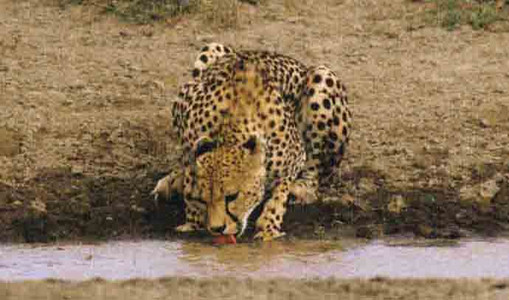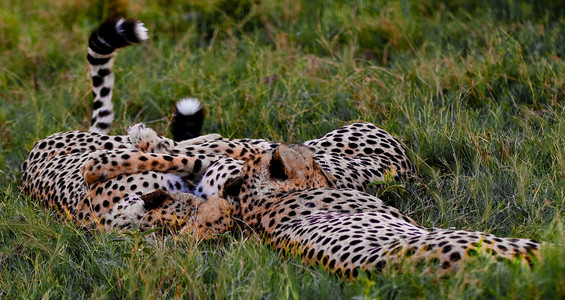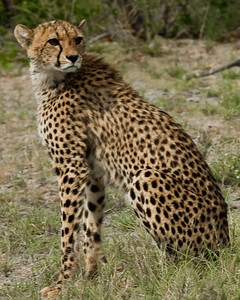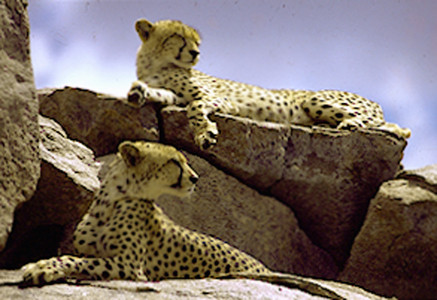
Cheetah
Two male siblings resting on a small kopje. Both seem to have their eyes closed, but their stomachs look pretty flat, so they probably could use a good meal. They're up on the kopje to have a good view of game. They will probably be hunting later. [Serengeti, Tanzania].
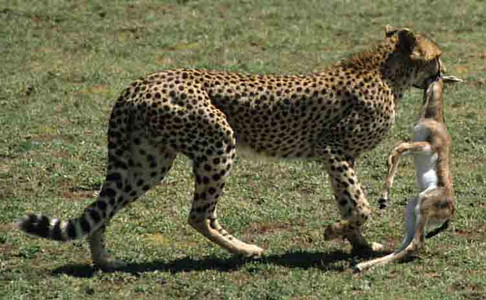
Cheetah
Young Cheetah male (one of the two in the previous image) carrying off a Thompson's Gazelle fawn that he found in the tall grass, well hidden there by its mother. This fawn is about 4-5 days old. From the herd, the mother watches the spot where she had hidden it, and from time-to-time comes to her fawn, nurses it, and cleans up its excrement to remove the scent. The fawn remains motionless, even when a predator comes close. But the cheetah knowingly made wide back-&-forth sweeps in the vicinity of the grazing gazelles, and found this one. We followed the cheetah to a small kopje with a shade-tree and saw him devour the fawn. See next image: [Serengeti, Tanzania].
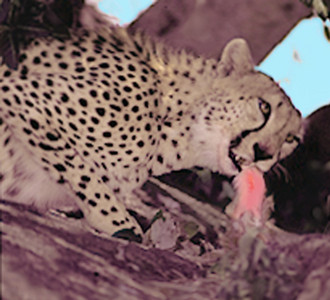
Cheetah
The Cheetah male of the previous two images is enjoying the meal of the impala fawn. [Serengeti, Tanzania].
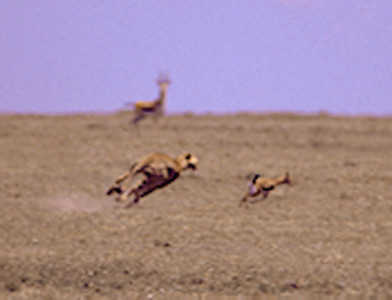
Cheetah
A Cheetah cannot capture this impala fawn like other members of the cat family do. The cheetah has paws like a dog which cannot fold or grasp with its claws. It must pursue the fawn, trip its hind leg with its fore-paw while in full run. It then seizes the throat in its jaws. Thus, the chase to obtain a kill! A little further on in these cheetah pictures, you will see a juvenile, of about eight months, practicing the 'tripping procedure' on its sibling. The cheetah uses its tail for balance as the prey makes evasive sharp turns. [Serengeti, Tanzania].
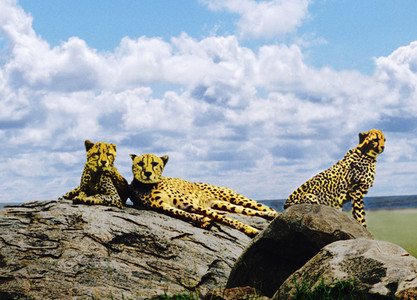
Cheetah
Cheetah mother with her 2 sub-adult cubs are resting on a small kopje. This would give them the advantage of seeing game at a distance, but I believe that they were just interested in resting. From the cubs' birth, the mother is totally responsible for providing the food for her offspring. [Serengeti, Tanzania].
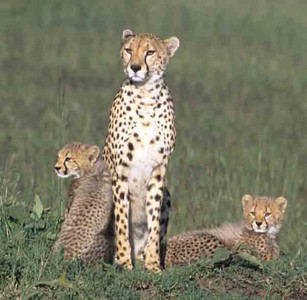
Cheetah with 2 Young Cubs
Cheetah (F) with 2 young 4 mos. cubs The young cheetah cubs thick hair on their necks and along their spine will disappear as they grow older. The mother is totally responsible for the rearing of her cubs; the male is absent after conception. Cheetahs do not like eating carrion; thus, she and her cubs will eat only what mother freshly kills. She always uses the chasing-tripping-throat-crushing-method, described previously. [Masai Mara, Kenya].
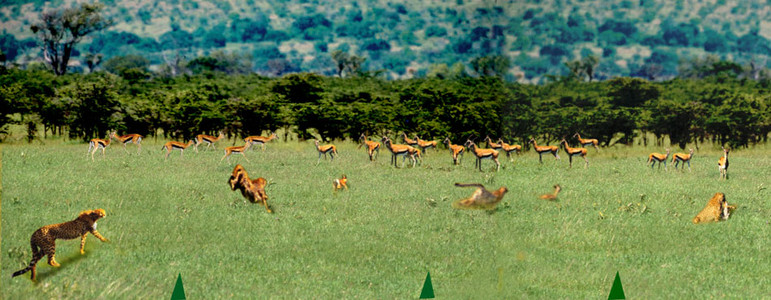
Cheetah Chase
Another chase: I have 'stitched' together 4 images that I took a few years ago of a cheetah hunting an impala fawn. I put the 4 images together better to depict what I actually witnessed and had photographed with a 'still' camera. The green markers at the bottom approximate the original images (after cropping)], because it was not feasible, with a still-camera, to reproduce well such a fast-moving action sequence, occuring over a large area, with a single image . The whole episode lasted only about 2-3 mins. The cheetah picks her target from a distance of perhaps 300 feet. She will pursue only that animal, even passing up those standing closeby her path where, it would seem, a sharp turn would produce a certain capture. But no, she can capture only by chasing & tripping, and then grabing and crushing the throat of the fallen animal! Remember, she has no retracting (prehensile) claws, like the leopard or lion, for grasping an animal. 1st segment: she selects her prey; 2nd segment: she pursues Impala fawn; 3rd Segment: she has almost caught up with the fawn; 4th Segment: Fawn is caught and killed. Note the mother impala, at far right background, watching [Masai Mara, Kenya].
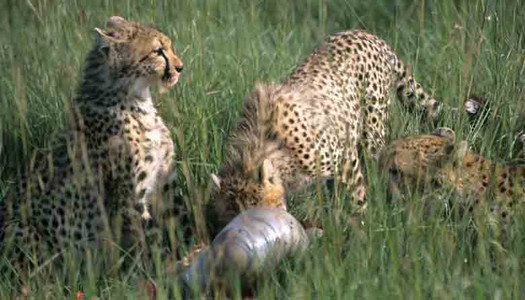
Cheetah feeding Cubs
Cheetah feeding Cubs: Although hungry, she keeps guard (L) & allows her near-grown cubs to eat first (unlike the other big cats). The mother will usually drag her kill to the shelter of a bush, because she wants to avoid detection by vultures whose circling would inform the hyenas of her and her cubs' location. What appears like an inflated bag is gas-distended intestine. The mother cheetah would be powerless to prevent any of the other larger predators from seizing the meat and killing her cubs. She probably would have to run off to avoid being killed herself. [Masai Mara, Kenya].
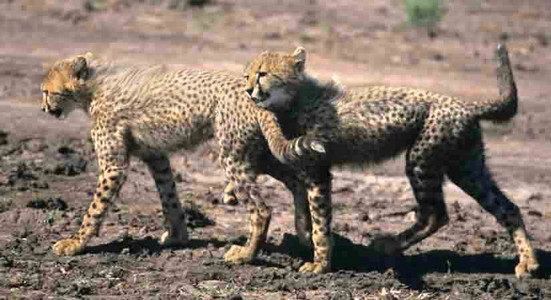
Cheetah Cubs
Eight-month-old Cheetah Cubs playing. A portion of the rear cub's R paw can be seen on the front sibling's L rear thigh. It is obviously critical that they learn to do this well, because this is the only way cheetahs can capture prey. Lions & leopards can hold prey in their claws while they crush the prey's throat. [Masai Mara, Kenya].
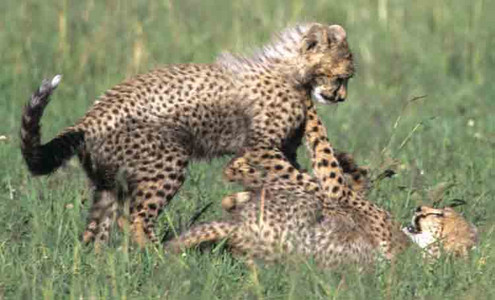
Cheetah Cubs
Two 8-month sibling Cheetahs tussling: (same individuals as in the preceding image) The cub on top has tripped the one lying on its back. Thus, play has a serious connotation here. [Masai Mara, Kenya].
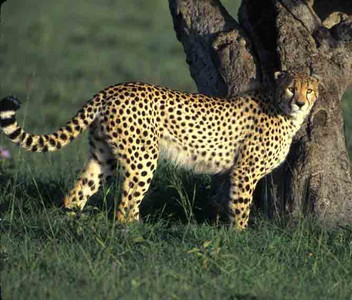
Cheetah
A fully mature, beautiful male cheetah. Compare the body of this male to that of the female in the next image. [Masai Mara, Kenya].
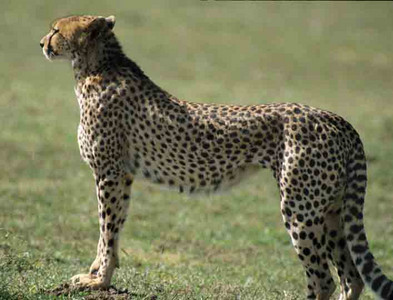
Cheetah
An adult female cheetah. Its body configuration is like a whippet's, and much thinner than a male's. It demonstrates why the female is able to run 35 mph--for short distances--in pursuit of swift prey. The fully grown, adult male may not be able to run as fast as a young male or a female, but he is much stronger and can take larger, slower prey. The usual brood is 2-3 cubs. Shortly after conception, the female is left with the entire responsibility for feeding, rearing and protecting the young. (Please see previous captions). [Serengeti, Tanzania].
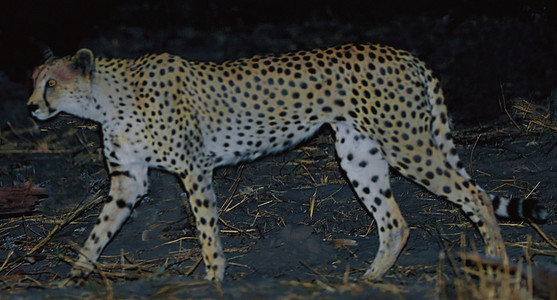
Cheetah
Cheetah: A fully grown female walking by herself at night. Again, the thin, whippet-like body-configuration. [Khwai, Moremi NP, Botswana].
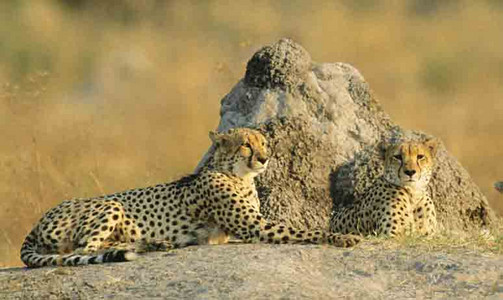
Cheetahs-adult males-Relaxing
Cheetahs:-Two young-adult male siblings resting at a termite mound. It is not uncommon for 2 brothers to stay together and stake out a territory where there aren't many lions or leopards.The two, working together, makes their hunting more successful. [Moremi NP, Botswana]
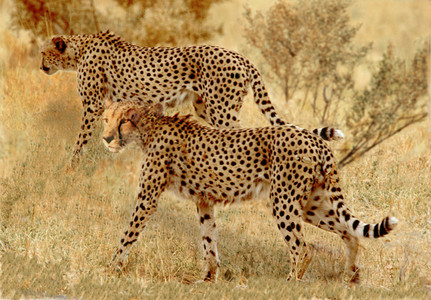
Cheetah
Two young adult male Cheetah brothers taking a walk in the grass. They do appear well nourished, but they look more like they might be looking for a small herd of Thompson's or Grant's Gazelles. [Serengeti, Tanzania].
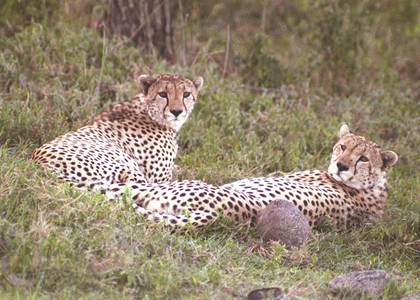
Cheetah
Two Cheetah brothers lying on the grass in The Crater many years ago. We never again saw any cheetah in The Crater during 3 subsequent trips. I rmember, on those subsequent trips, that the hyena population seemed to have increased considerably. Perhaps, too much competition for food was the reason for the absence of the cheetah. [Ngorogoro Crater, Tanzania].

Cheetah
Cheetah-dbl image: 2 older, mature male siblings resting in the woodlands that is very close to a wide-open plain where they prefer to hunt. They are larger and heavier than the those in the preceding images. This is an example of two males staking out--at least temporarily--a territory for themselves. [Busanga Plains, Zambia]
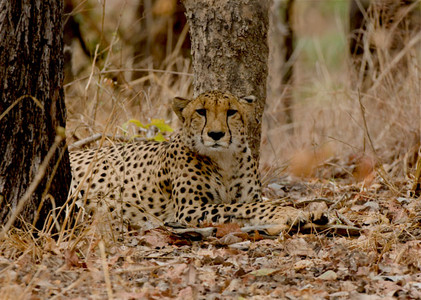
Cheetah
Cheeetah (male)- in woodlands: A beautiful male. Probably, one of the two seen in the preceding image, because I don't believe the 2 siblings would tolerate another male in this area. [Busanga Plains, Zambia].
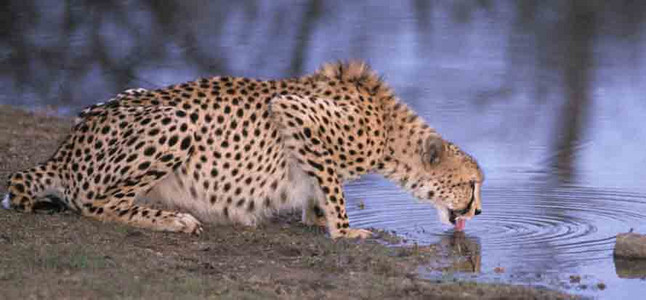
Cheetah drinking
Another adult female Cheetah drinking: Note this female has a congenitally abnormal tail. It is undersized and wound up in a cork-screw fashion, hanging uselessly in a knot at the animal's rear-end. One has to wonder whether being deprived of her 'balancing instrument', critically important during the pursuit of agile prey on the plains, is the reason. I have never previosly before seen this anomaly. The woodlands is not the usual habitat for cheetah.They prefer the plains where they can run at high speed. Certainly, her tail abnormality influenced her choice of habitat. Apparently, she has learned to hunt successfully in the bush, because she seems to be well-nourished. (Please see next image for better view of her rare congenital anomaly). [Sabi Sabi, Marine Camp, South Africa].
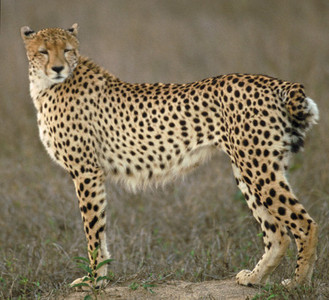
Cheetah
This is the same female Cheetah as in the previous picture. I wanted to provide a better view of this very unusual congenital deformity--the useless stunted tail. [Sabi Sabi (Marine Camp), South Africa].
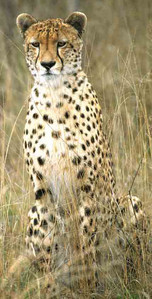
Cheetah
A frontal view of the previous female Cheetah--a beautiful specimen, except for her tail. [Sabi Sabi, Marine Camp, South Africa].
